At the top of our map, north of the Platte River, is the town of Kearney. Old Fort Kearny is south of the river in Kearney County, but the town developed along the Union Pacific Railroad north of the river in Buffalo County. We know that the immigrants landed there on their way to the Svea / Phelps settlement, and that they scavenged buffalo bones to sell in Kearney in the early years. What we have learned from sources in Kearney, is that their agent for the buffalo bones was one of their own countrymen. Carl F. Bodinson came to Kearney in 1878 and operated a grocery store and later a hardware store there. Bodinsons were in business in Kearney until 1964!

Bodinson's: the market for buffalo bones
"Swedish and Norwegian Lutherans had congregations in Kearney and erected a brick church as early as 1886. They did not worship together but had separate pastors and meeting times. The church still stands at 2523 Avenue A and is now (1996) the home of the Kearney Jubilee Center. No further history is known of these congregations." -Buffalo Cty website
While we are accustomed to church leadership originating in the cities and moving outward to the towns and countryside, the early years reveal a quite different dynamic. As in the Omaha area, the strong churches were in the rural areas and only with difficulty were they able to establish congregations in the city. In support of this is the fact that both Swedish congregations in Kearney were "aided churches"; in the case of the Free Mission, into the 1950's.
While this was indeed true, it is now the case that these same two congregations are among the largest and most successful churches in the city of Kearney. Their stories are interesting ones. The above quote from a contemporary Kearney historian agrees with Augustana historian Sandahl in the matter of Norwegian-Swedish cooperation. Where they do not agree are in the following details: Sandahl has a frame building rather than a brick one, and has the Norwegian congregation disbanding shortly after the two groups went their separate ways. The Kearney Jubilee Center does indeed still stand, but its relationship to the Norwegian Lutherans is in question. Perhaps they built it later.

The Norwegian building survives
It is also true that the Scandinavian Lutherans initially located "south of the tracks." With the Union Pacific mainline constituting "the tracks", we have a more dramatic division than is usually the case for a simple railroad line. For Sandahl, this was the "wrong side of the tracks." When he, representing the Nebraska Conference of Augustana, attempted to counsel the Kearney Lutherans to sell their building to the Syrian (Antiochian) Orthodox who dominated the neighborhood he met with a rebuff. "Never before or since has he (says Sandahl, speaking of himself) in such plain terms been told of his personal incompetency, as well as that of the Conference, to handle church affairs."

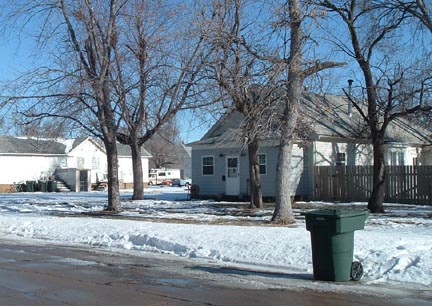
The first Augustana church and its now typically vacant site
Why are so many old church sites vacant?
(that house to the right appears to have survived!)
These Syrian Orthodox Lebanese Christians deserve more than a passing mention. Their coming to Kearney is most likely related to the construction of the railroad, as had been the case with the Swedes in Omaha. Their determination to have a house of worship resulted in their sending one of their own to seminary back east, and that priest, Father Yanney served Kearney for many years. Their St. George Antiochian Orthodox church was reckoned by him as being the third oldest in the U.S. Others contend it is the fifth, still a remarkable fact for Kearney. Though their neighborhood was south of the tracks, their first meeting place was inconveniently on the north. In other words, the Swedes and the Syrians had the same problem, but on opposite sides of the railroad! Members of our family who lived in Kearney still count descendants of these Syrians (the Shadas) as friends.
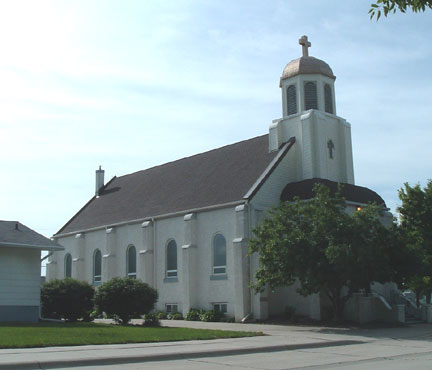
St. George Antiochian Orthodox Church
The Buffalo County Historical Society website contains biographical material on the photographer A.T. Anderson. The Anderson family had come to the Svea/ Phelps settlement, and their son, A.T., acquired a small photography studio in the Swedish part of Kearney. This studio was also used as a meeting place for the Free Mission friends, the benches being kept outside and sometimes remembered for their frozen condition. The photography studio thrived and was relocated in its own building in the business section where it continued to be operated by the family into modern times.
The Free Church Golden Jubilee historian is pensive about the Kearney congregation; their beginnings in 1888 are noted, and eleven years later there is a formal organization under the chairmanship of A.T. Anderson. Though "there is a fine church building," the congregation has been receiving assistance from the Nebraska District Society.
An axiom for locating Swedish church sites is: "if you have found one denomination's site, you are probably in sight of, or at least very close to, the other ones'" Time and again this has proven true, and is true in Kearney. Not only the Oregon Trail, the Mormon Trail, the Platte River and Union Pacific lead to Kearney; but the Lincoln Highway (U.S. 30) and now Interstate 80 as well. So the Lincoln Highway, which is 25th Street in Kearney, became a commercial thoroughfare. On and near this street were the next generation of Swedish churches.
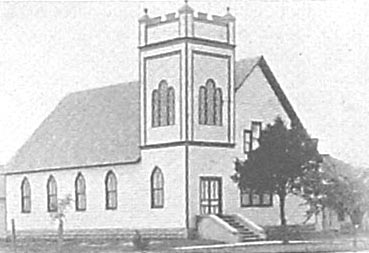
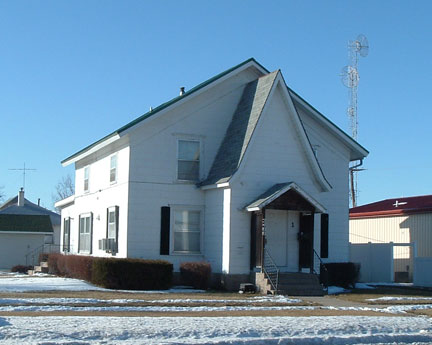
The Free Mission Church in the 1930's, on 25th St.
and just around the corner in the 50's; could it be the same building?
The Free Mission congregation was the first Swedish group on 25th Street, building there at Avenue C in 1890. Rev. H.G. Swedell is listed by a Kearney historian as their first permanent pastor. It is also noted that "Financial problems and disputes over doctrines marked the early years of the church, and it was closed at various times." This may correspond with the Lutheran historians note that : "...another Swedish congregation was disbanded and some of its members came over to us." (1919)
In the same vein, we have this vignette from visiting Lutheran Pastor K.G.W. Dahl: "In Kearney there is, naturally, a free-congregation and they, of course, they do all they can to work against the Lutheran church, but--imagine this--the other evening their entire congregation was present in my church. I have never preached as I preached that evening, so said each one, and I know that I have never felt God's nearness as clearly as I did then. The people even said that if I could stay here longer there soon would be no free-congregation." -1904
It must be noted, that while things were at a low ebb for the Lutherans in Kearney at the turn of the century with only 17 members, just a few miles down south Bethany numbered in the hundreds not to mention the "daughter" churches with hundreds more. The Nebraska Conference urged these Kearney district churches to assume responsibility for Kearney, but they seemed strangely cool to the idea. Kearney had experienced a "boom" time, followed by a great "bust" as here reported:
"On May 1, 1891 the new Opera House was opened by a glittering crowd which included Governor James E. Boyd who had operated a [road] ranch near Gibbon in the early days. Governor Boyd commented he never dreamed that such a town, or such a theater would be built where he had once chased buffalo. Festivities at the Opera House marked the beginning of the end. The grandiose plans were based on credit; the top-heavy financial structure toppled of its own weight. All four of the Kearney banks failed so the investors salvaged what they could and returned East. Of the 1,400 homes in Kearney, half stood vacant. " -Buffalo Cty website
Little wonder, then, that the farmers of Phelps County would be wary of investing in Kearney!
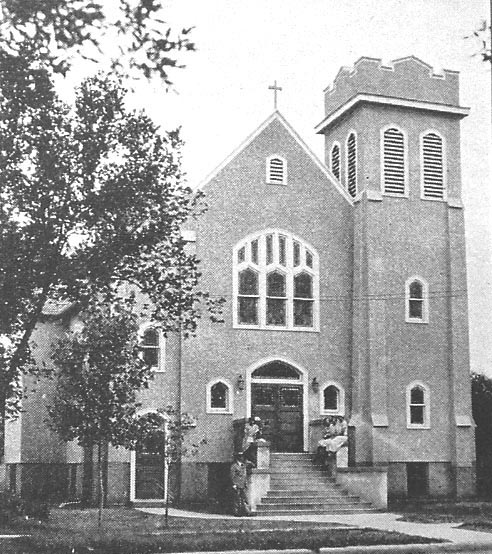
The Kearney Lutheran Church in the 1930's, also on 25th St.
Though the stubborn resolve of the Kearney Lutherans was keenly remembered by Sandahl, it must be said that he evidently also made a strong impression on their leaders, for in just a year they had determined to make the move he recommended, up to 25th Street. There they built a substantial church within a block of the Free Mission's, in part through the gift of the well-known merchant Farris (Ferris), but remained plagued by debt and want of a stable pastorate. To illustrate, the Nebraska Conference paired them in turn in a series of joint pastorates with the weak Minden-Norman parishes, and the distant Saronville and Hershey parishes.
No other Swedish Lutheran church in Nebraska had received as much aid as Kearney, and still in the 1930's the church is reported as "greatly in need of repairs" and in debt. The Conference had succeeded in sending the "venerable Rev. G. Peters" there for nine months to see what he could do. Peters was indeed a seasoned veteran, having served in Moline, Illinois for 25 years and in the strong Iowa Halland settlement at Red Oak as well. He did make a significant contribution to keeping Kearney afloat.
The "great depression" was keenly felt in Nebraska, but once it was over and the postwar prosperity returned it was the Kearney Swedes' time to prosper. From all that we have seen, one could hardly anticipate the degree of their success from that time to this. Of the people and details of that recovery we can tell little, but clearly it was remarkable. We have the evidence in the form of their present churches, now thriving beyond all hopes in the early years.

The Kearney Free Church is outgrowing even this building
When the commercial value of 25th Street lots rose to new heights, both the Swedish Lutherans and Free Mission people apparently "cashed in" on their prime locations and moved elsewhere. Family members remember the Mission location just around the corner from the 25th Street location in a building still standing as pictured. From there they moved north and westward to a large church, then again northwards, and now contemplate yet another building project to accommodate their growth. Even the state conference headquarters of the Evangelical Free Church is in Kearney.

The Kearney First Lutheran Church today
The Lutherans moved north and east, now occupying an entire block in the complex pictured. It is safe to say that those early Swedes who endured years of frustration in Kearney would not believe the outcome of their labors. The Kearney story has been a good one.